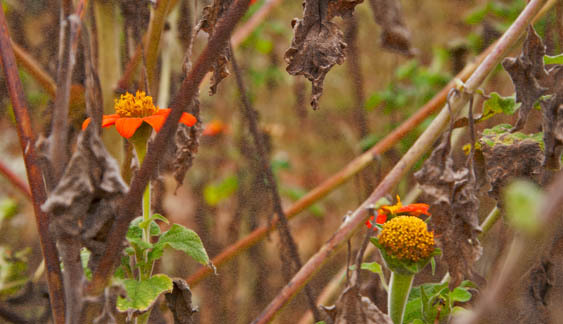Autumn at Anson Mills
October 2013

It crept us on us. We didn’t notice fresh stirrings of interest in two particular Anson Mills ingredients until four months ago. Then we had to wonder what might be driving demand for our coarse yellow cornmeal and farro piccolo, and whether the two had any meaningful connection with each other. We believe there is such a connection, and that it is related to an overall heightened interest in rustic, farmstead ingredients—and the way pre-industrial small farms in the United States and Italy grew and processed their own food.
In America, small farms grew and milled corn by hand to make foods for their table. During fall harvest, they produced plenty of beautiful new crop coarse cornmeal sifted from corn grist. There is a striking difference between coarse cornmeal and run-of-the-mill cornmeal, and the former is fast disappearing—to the point where grocery stores and shops in our region do not offer it at all. A word about the Southern culture of coarse cornmeal around Charleston: no Sea Islander would ever use fine cornmeal for breading and frying. These foodways call for seafood you yourself caught; a black iron skillet seasoned to a mirror-like sheen; and fresh, small-mill, hand-produced, very coarse meal to coat the seafood. Today we’re seeing a rise in understanding and appreciation of this style of food even as it disappears.
Just 10 years ago, farro piccolo production in Italy had all but vanished. Before the Industrial Revolution, however, farro was grown in obscure reaches of Garfagnana and harvested abundantly in the fall. Rather than milling it, farmers tossed whole farro berries instead of pasta into the soup pot, along with local fall vegetables. Today, Tuscans in particular have begun to revisit this legacy and cook according to their ancient traditions of rural small-farm foods. On our side of the Atlantic, interest in Italian small-farm heritage foods is just beginning to surface.
At Anson Mills, we’re drunk with harvest bounty now—we call this the Season of Moonshine. So dive in with us and explore what is new, ancient, unique, and memorable in the culture of rustic foodways.

Cornmeal-Crusted Black Skillet Fish with Shallot Sprinkles
Quick-curing fish in lemon before sprinkling it with sea salt as we do here harkens back to the time when folks cured their fish in a bucket of seawater and made their own local salt. This quick cure is the only thing between your fish and cornmeal, which locks in the fish’s flavor and moisture so the coating develops its quintessentially Southern crackling-crisp finish. No flour, no egg dip, no nothin’.We noodled around and doctored the cornmeal with homemade dehydrated garlic and shallots, then promptly backed off the garlic altogether, and deconstructed the arrangement further by sprinkling crisp, dried shallots on top of the fish after it was cooked. A superbly simple pan-fry of striking flavor and texture to serve with greens and winter squash or on a bun. You will love it.
Farro Minestrone
Minestrone is a riotously bountiful soup, deeply layered and profoundly comforting to slurp from a spoon. It is also one of the oldest foodways in Italy. Originally made with ground cereal grains, available vegetables, and broth, we tricked ours out just a bit with the fall’s best vegetable flavors, rich chicken broth, marbled pancetta—and farro piccolo. Does this soup need farro? Arguably not. But what a terrific postscript its quenching chewiness makes!
Happy Season of Moonshine, y’all—and Good Food!